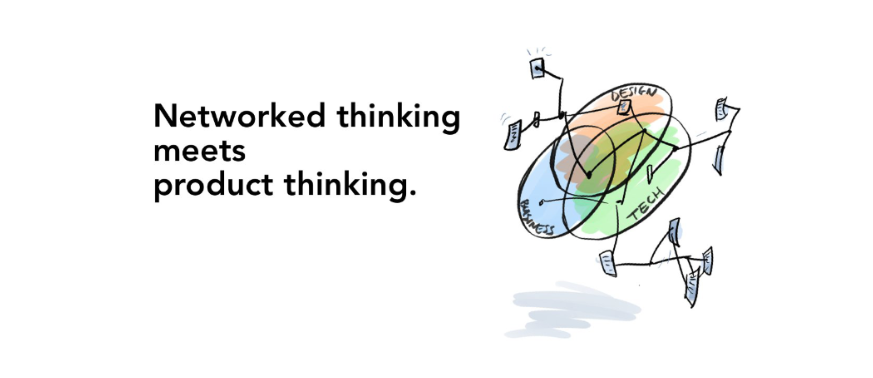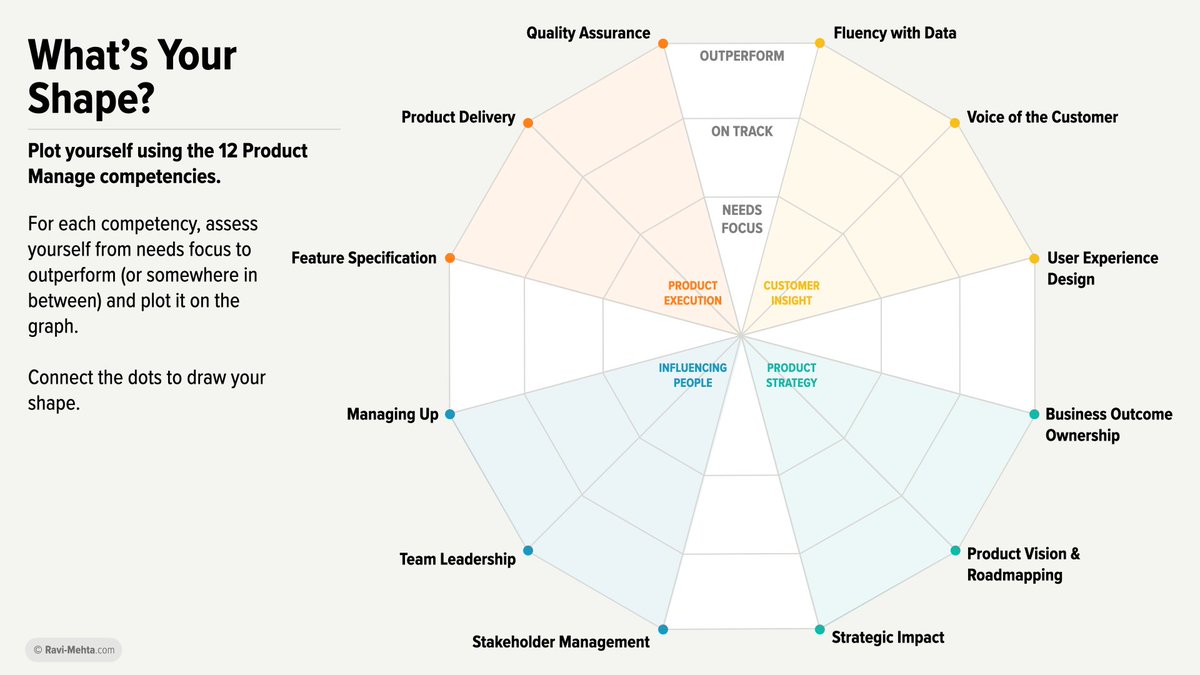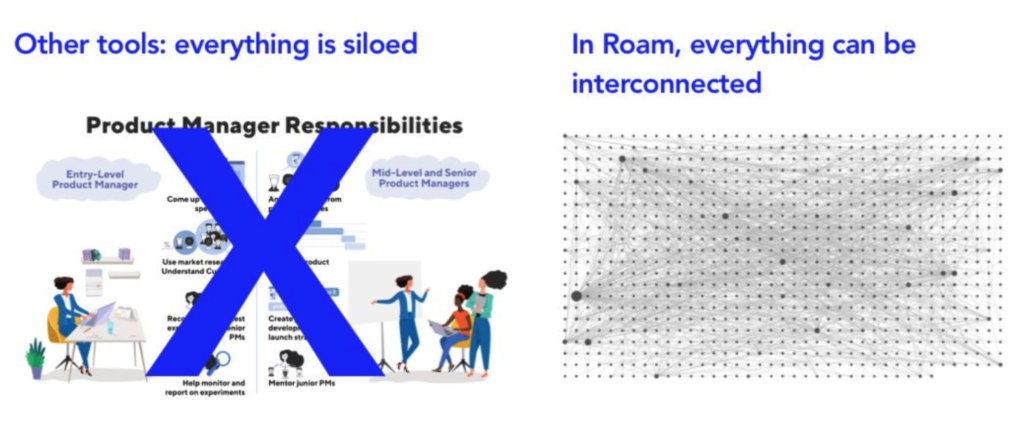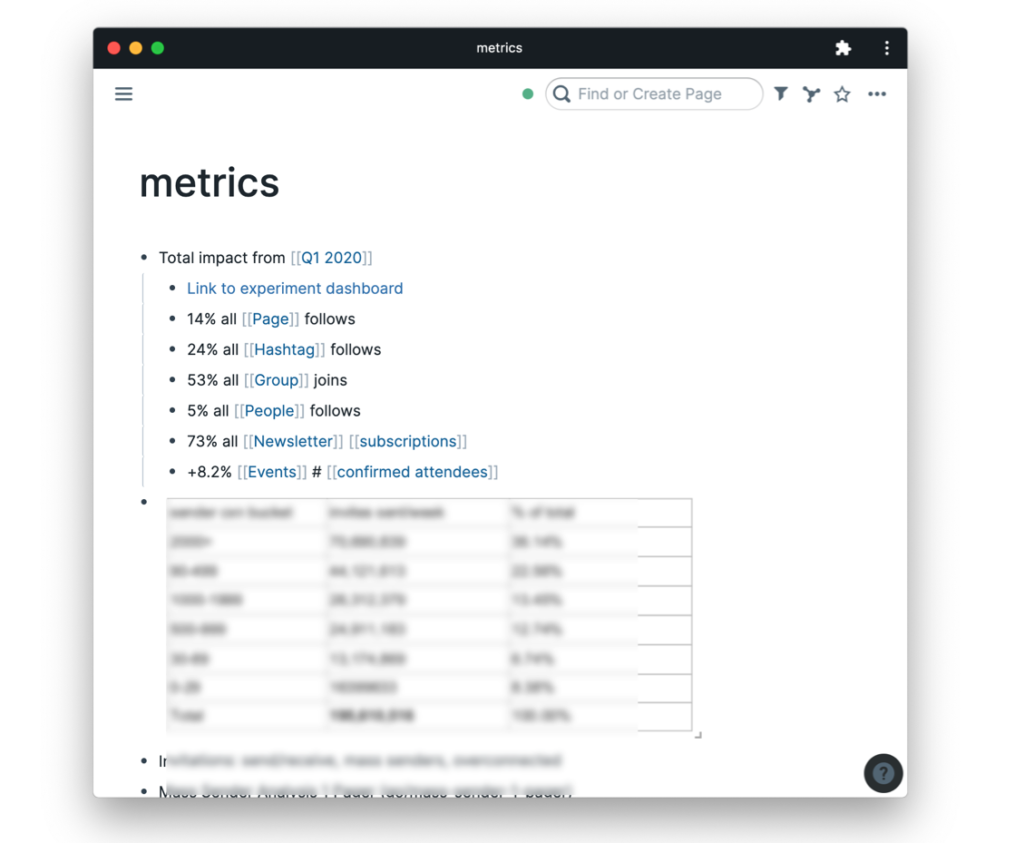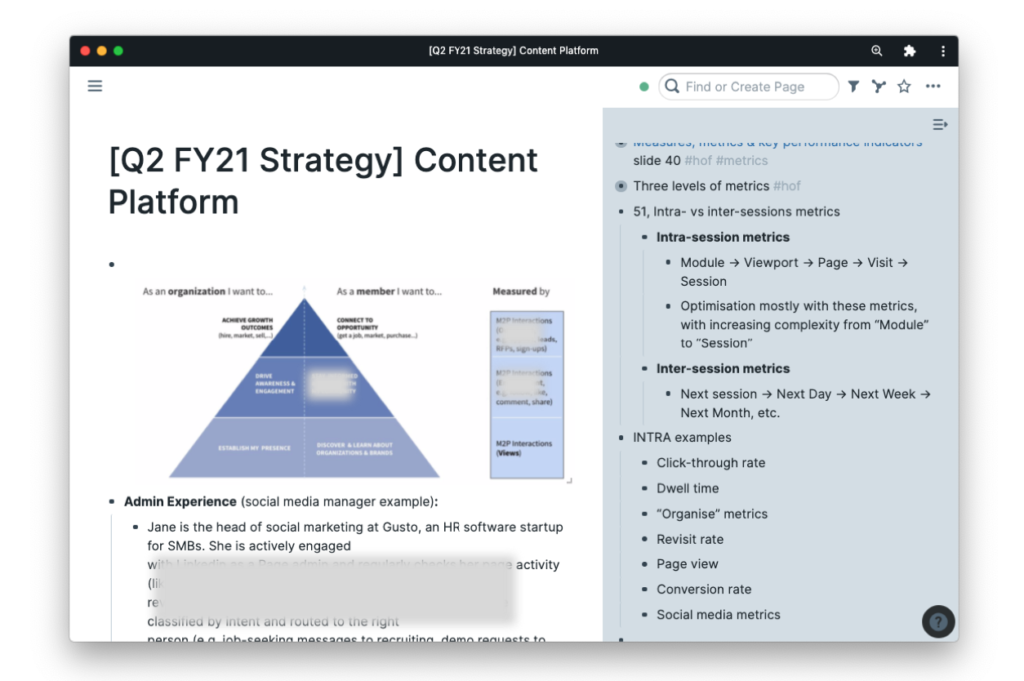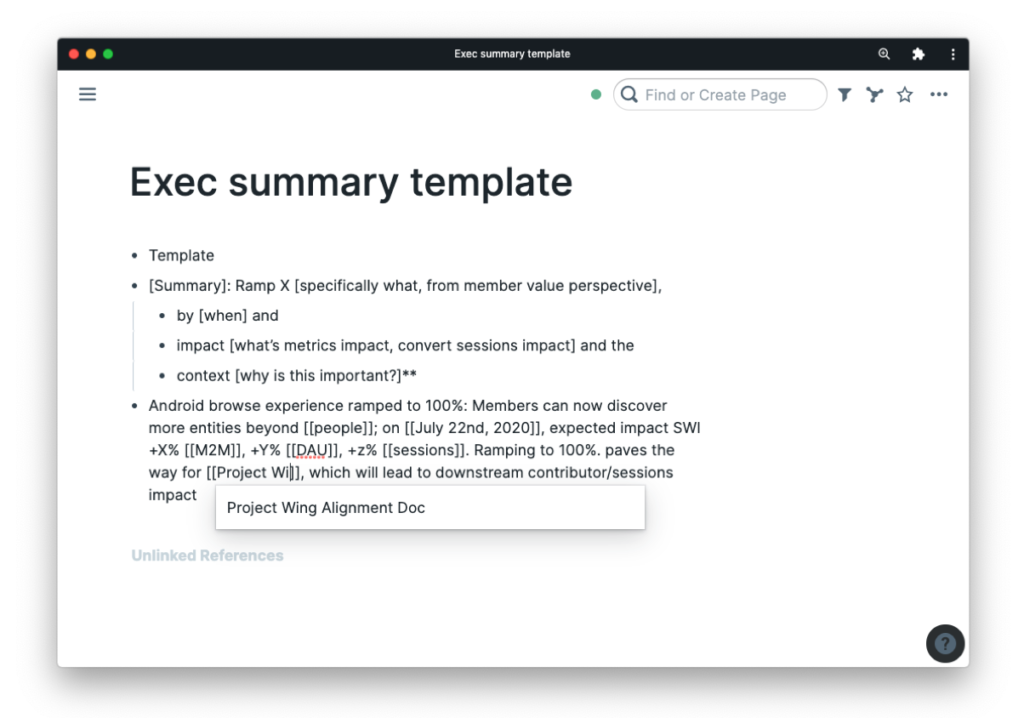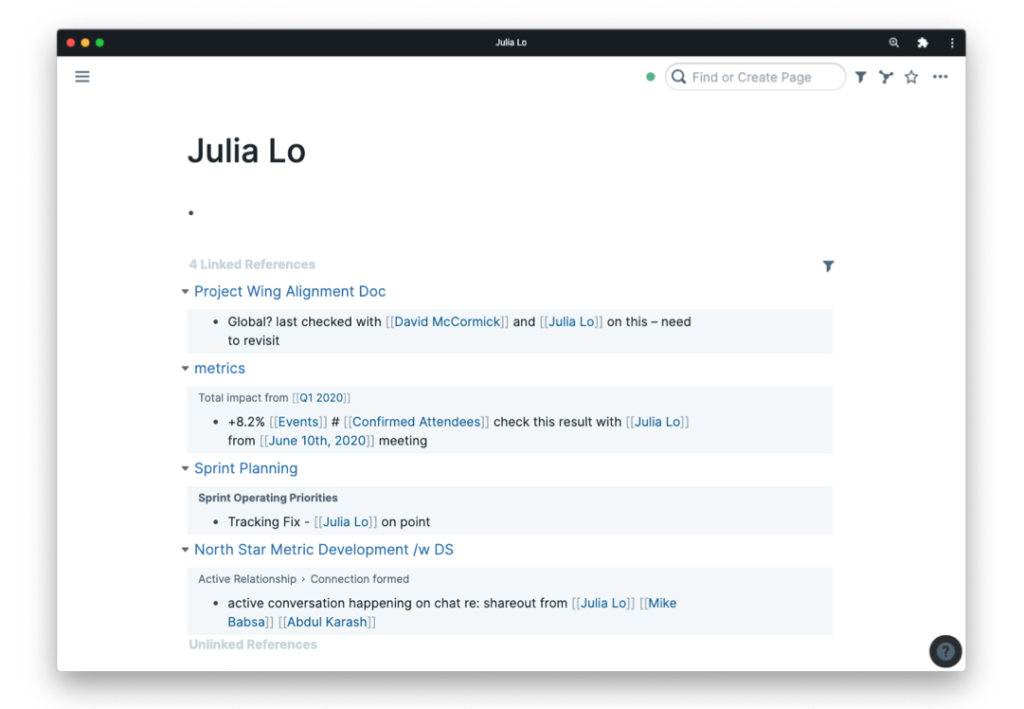Introduction
A product manager’s life is pretty hectic due to the interdisciplinary nature of the job. We love the opportunity to sit at the intersection of tech, design, and business, but it means working with a lot of different inputs in different forms from various stakeholders.
In this article, I’m going to make the argument that the practice of networked thinking can help product managers excel in their roles by making it easier to store, recall, and cross-reference ideas. The benefits of knowledge graphs and dependency graphs afforded by a networked thinking tool like Roam pair very well with the core product manager competencies of execution, insight, strategy, and influencing.
Excelling at core product management competencies
There are many models for assessing a PM’s set of skills and competencies but, for simplicity, let’s use Ravi Mehta’s categories from his excellent Product Competency Toolkit. He suggests that a PM should be measured on four key dimensions: execution, insight, strategy, and influencing:
- Product Execution (the ability to build exceptional products) — eg. Feature specification, Product delivery, Product quality assurance
- Customer Insight (the ability to understand and deliver on customer needs) — eg. Fluency with data, Voice of customer, User experience design
- Product Strategy (the ability to drive business impact via product innovation) — eg. Business outcome ownership, Product vision/roadmapping, Strategic impact
- Influencing People (the ability to rally people around the team’s work) — eg. Managing up, Team leadership, Stakeholder management
This model is particularly comprehensive as it also accounts for changes in seniority and responsibility over time: “PMs need to work their way clockwise through the competencies as they get more senior — Product Strategy and Influencing People are critical for Product Leaders. This requires a shift from managing products to managing people and strategy.”
As PMs we know that these competencies overlap constantly on a day-to-day basis. With networked thinking, there is even more opportunity to build interconnectivity among all the different pieces of information within these competencies. By doing so, we can reduce information redundancies, find new insights and cross-leverage knowledge.
Networked thinking definition and benefits
Anne-Laure Le Cunff has defined networked thinking as follows:
“an explorative approach to problem-solving, whose aim is to consider the complex interactions between nodes and connections in a given problem space. Instead of considering a particular problem in isolation to discover a pre-existing solution, networked thinking encourages non-linear, second-order reflection in order to let a new idea emerge.”
The key feature of Roam that enables networked thinking is bi-directional linking which is the ability to create interconnectivity between nodes of information (sentences, notes, etc). This allows you to create a network of your information.
In the world of product management, these benefits can be highly beneficial in the following ways:
- Knowledge graphs as nodal networks — In networked thinking, the atomic unit is a piece of knowledge that is represented as a node. Any piece of information – eg. an email from your engineering manager, a key data point in a share out, a design review – is a node that can connect to other nodes. Imagine if these individual nodes of knowledge can reference each other. This structure makes it inherently easier to store, recall, and cross reference ideas.
- Dependency graphs — Having all your information represented as a knowledge graph is also beneficial as you can trace every node’s connection. This is particularly useful when you want to trace a decision you made, past meeting notes, any misalignments with other teams, etc. As the Roam white paper puts it: “the ability to use clearly defined sets within a dependency graph helps to resolve ambiguity, reducing the chances of participants talking at cross-purposes, or deliberate…strategic equivocation.”
- Nonlinear causality — As product people, it is our job to problem solve, and almost any sufficiently complex problem is never linear. We are used to this way of thinking, and Roam provides an elegant tool to identify patterns, clusters, and counterintuitive insights.
- Collaborative problem-solving — Though the collaborative features of Roam are in still early stages, the ultimate goal of the company is to “create a platform for collaborative research and learning” with the bigger vision for human knowledge as “a collective, open-source intelligence, constantly rearranging, iterating and evolving in the pursuit of truth.” Better collaborative features would allow teammates to easily reference ideas from each other, and update knowledge dynamically. Product practitioners from different industries would also be able to reference each other’s learnings and knowledge.
Applying networked thinking to product management
Let’s jump into examples to make these concepts more concrete. Here’s something that should be familiar to all product managers. A day in the life of a PM – my actual work calendar, blurred out for privacy:
Each of these meetings and blocks of scheduled time represent some combination of execution, insights, strategy, or influencing – each with their own set of unique stakeholders and deliverables.
Let’s pick a few examples:
- Design sync (explorations phase)
- Experiment review
- Metric development meeting with data science
- Strategy doc revision
- Prep exec summary for VP
- Upcoming sprint planning
- Partner team alignment meeting.
In a linear-thinking siloed approach, each of these would have their own documents, meeting notes, and references. With a networked thinking tool like Roam, it looks more like this:
Every key deliverable for every block of time on my calendar is going to require different amounts of inputs from other sources. As product managers, having information siloed is counter to our workflow and thinking process. Roam makes it easier to amplify our natural strengths by providing the tools and features to interlink pieces of information from our day-to-day activities.
Networked Thinking in Practice
Here are some examples of how networked thinking can be practically applied to the four core product management competencies.
1. Product Execution
The ability to build exceptional products. eg. Feature specification, Product delivery, Product quality assurance
The overarching aha moment of using Roam with product management day-to-day is that notes can “talk to each other”. In the example below, I tag a note from a design review with [[sprint planning]], knowing that it needs to be addressed at a sprint planning meeting later in the week. This means it shows up automatically in the sprint planning page and I’m good to go.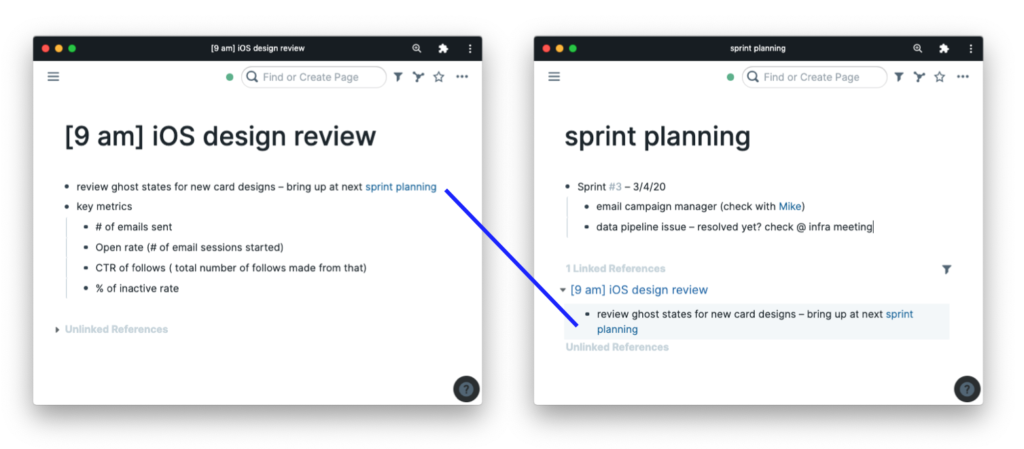
2. Customer Insight
The ability to understand and deliver on customer needs eg. Fluency with data, Voice of customer, User experience design
Let’s say I’m meeting with the data science team about developing a new metric for a key initiative. These meetings usually require a fair amount of prep and discussion, pulling in learnings from various sources. Using Roam, I no longer have to dig into siloed documents of experiment findings and metrics heuristics I’ve collected, but instead can interact with nodes of information fluidly.
In the example below, I can do the following:
- find out key results from an experiment last quarter
- go to that individual team’s page
- access key metrics conversions.
3. Product Strategy
The ability to drive business impact via product innovation eg. Business outcome ownership, Product vision/roadmapping, Strategic impact
Roam particularly shines as a creative tool when it’s time to assemble pieces of information together – e.g. writing a strategy doc. The more information that is put into Roam, the more opportunity there is for creating interconnectivity between the nodes of information, and the more opportunity for generating insights.
In the example below, as I write the first draft of a strategy doc, I can:
- Reference key exec decisions from previous quarterly plans
- Reference key data points to back up assertions via [[metrics]]
- Bring in [[product principles]] from other sources. The references are dynamic, so if these principles are adjusted, that change will be reflected in the strategy doc.
4. Influencing People
The ability to rally people around the team’s work eg. Managing up, Team leadership, Stakeholder management
A core pillar of the PM job is to effectively manage relationships. In the example below, I have a tried and true template of what makes an effective executive summary. With Roam, it’s now plug and play. Whenever I need to create a crisp, succinct message to clearly articulate my team’s updates, I can pull in information from other sources quickly and send it off in a timely manner. Previously, this would have taken a lot of digging around, and probably some lack of follow up.
For 1-on-1s and recurring meetings, you can auto-build a mini-CRM of all the individuals that you work with just by tagging them. Let’s say I have a check in with Julia Lo coming up. I don’t need to build a page manually since every time I’ve mentioned Julia anywhere is consolidated on one Roam page. This is particularly useful when you’re working with several teams across several functions at any given time.
Other functionalities
There are lots of other ways that Roam can improve a PM’s life. These include: Quarterly Planning, Performance Reviews (managers + DRs), Knowledge Repo, Data Analysis, Design Workshopping / Ideation, etc. These require their own deep dive — and you can find out more here.
Conclusion
I’m a big believer in Roam Research because of their underlying philosophy that networked thinking will lead to better thinking, learning and problem solving. The solidity of this vision makes me confident that a market for networked thinking tools for product managers is ripe.
A lot of the less enjoyable parts of product management may be alleviated with a networked thinking tool. Misalignments, lack of transparency and miscommunication may all be sorted out more efficiently if networked thinking is broadly adopted by product teams.
I believe this way of thinking has the potential to improve the way that product teams work by increasing trust and empathy and lead to more exciting and creative product solutions and drive value.

